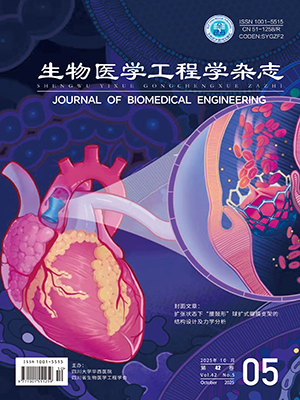| 1. |
World Health Organization. Depression (2021) [2022-01-13]. https: //www.who.int/zh/news-room/fact-sheets/detail/depression.
|
| 2. |
Beppi C, Ribeiro Violante I, Scott G, et al. EEG, MEG and neuromodulatory approaches to explore cognition: Current status and future directions. Brain Cogn, 2021, 148(1): 105677.
|
| 3. |
Chen G, Zhang Y, Li X, et al. Distinct inhibitory circuits orchestrate cortical beta and gamma band oscillations. Neuron, 2017, 96(6): 1403-1418.
|
| 4. |
邸新, 饶恒毅. 人脑功能连通性研究进展. 生物化学与生物物理进展, 2007, 34(1): 5-12.
|
| 5. |
Takamiya A, Hirano J, Yamagata B, et al. Electroconvulsive therapy modulates resting-state EEG oscillatory pattern and phase synchronization in nodes of the default mode network in patients with depressive disorder. Front Hum Neurosci, 2019, 13(1): 1-9.
|
| 6. |
Fingelkurts A A, Fingelkurts A A. Altered structure of dynamic electroencephalogram oscillatory pattern in major depression. Biol Psychiat, 2015, 77(12): 1050-1060.
|
| 7. |
Li X, Jing Z, Hu B, et al. A resting-rtate brain functional network study in MDD based on minimum spanning tree analysis and the hierarchical clustering. Complexity, 2017, 2017(1): 1-11.
|
| 8. |
Friston K J, Frith C D, Liddle P F, et al. Functional connectivity: the principal-component analysis of large (PET) data sets. J Cereb Blood Flow Metab, 1993, 13(1): 5-14.
|
| 9. |
Kirsten A, Seifritz E, Olbrich S. Electroencephalogram source connectivity in the prediction of electroconvulsive therapy outcome in major depressive disorder. Clin EEG Neurosci, 2020, 51(1): 10-18.
|
| 10. |
Tsolaki E, Narr K L, Espinoza R, et al. Subcallosal cingulate structural connectivity differs in responders and nonresponders to electroconvulsive therapy. Biol Psychiatry Cogn Neurosci Neuroimaging, 2021, 6(1): 10-19.
|
| 11. |
Hill A T, Hadas I, Zomorrodi R, et al. Modulation of functional network properties in major depressive disorder following electroconvulsive therapy (ECT): a resting-state EEG analysis. Sci Rep, 10(1): 17057.
|
| 12. |
Ghosh P, Roy D, Banerjee A. Organization of directed functional connectivity among nodes of ventral attention network reveals the common network mechanisms underlying saliency processing across distinct spatial and spatio-temporal scales. NeuroImage, 2021, 231(1): 117869.
|
| 13. |
Lin Y, Chang C C, Huang C C Y, et al. Efficacy and neurophysiological predictors of treatment response of adjunct bifrontal transcranial direct current stimulation(tDCS) in treating unipolar and bipolar depression. J Affective Disord, 2021, 280(1): 295-304.
|
| 14. |
Gurel S C, Mutlu E, Basar K, et al. Bitemporal electroconvulsive therapy efficacy in bipolar and unipolar depression: A retrospective comparison. Asian J Psychiatr, 2021, 55(1): 102503.
|
| 15. |
Ainsworth N J, Sepehry A A, Vila-Rodriguez F J T J O E. Effects of ketamine anesthesia on efficacy, tolerability, seizure response, and neurocognitive outcomes in electroconvulsive therapy: A comprehensive meta-analysis of double-blind randomized controlled trials. J ECT, 2020, 36(2): 94-105.
|
| 16. |
Zhang J, Cheng W, Wang Z G, et al. Pattern classification of large-scale functional brain networks: identification of informative neuroimaging markers for epilepsy. PLoS One, 2012, 7(5): e36733.
|
| 17. |
van Dellen E, Sommer I E, Bohlken M M, et al. Minimum spanning tree analysis of the human connectome. Hum Brain Mapp, 2018, 39(6): 2455-2471.
|
| 18. |
Borgheai S B, Mclinden J, Mankodiya K, et al. Frontal functional network disruption associated with amyotrophic lateral sclerosis: An fNIRS-based minimum spanning tree analysis. Front Neurosci, 2020, 14(1376): 613990.
|
| 19. |
Wang R, Liu M, Cheng X, et al. Segregation, integration and balance of large-scale resting brain networks configure different cognitive abilities. Proc Natl Acad Sci USA, 2021, 118(23): e2022288118.
|
| 20. |
Tian S, Xu G, Yang H, et al. The effect of brain functional network following electroconvulsive therapy in major depressive disorder. COMPEL, 2023, 42(1): 149-158.
|
| 21. |
Voineskos D, Levinson A J, Sun Y, et al. The relationship between cortical inhibition and electroconvulsive therapy in the treatment of major depressive disorder. Sci Rep, 2016, 6(1): 37461.
|
| 22. |
Bruder G E, Sedoruk J P, Stewart J W, et al. Electroencephalographic alpha measures predict therapeutic response to a selective serotonin reuptake inhibitor antidepressant: Pre- and post-treatment findings. Biol Psychiat, 2008, 63(12): 1171-1177.
|
| 23. |
刘潇雅, 刘爽, 郭冬月, 等. 抑郁症脑电特异性研究进展. 中国生物医学工程学报, 2020, 39(3): 351-361.
|
| 24. |
柏同健. 电休克疗法调控抑郁症情绪与记忆的神经机制研究. 合肥: 安徽医科大学, 2019.
|
| 25. |
Farzan F, Atluri S, Mei Y, et al. Brain temporal complexity in explaining the therapeutic and cognitive effects of seizure therapy. Brain, 2017, 140(4): 1011-1025.
|
| 26. |
Scangos K F, Weiner R D, Weiner R D, et al. An electrophysiological biomarker that may predict treatment response to ECT. J ECT, 2019, 35(2): 95-102.
|
| 27. |
史丹丹. 首发重性抑郁症患者电休克治疗前后默认网络的fMRI研究. 重庆: 重庆医科大学, 2016.
|
| 28. |
Hakulinen C, Fried E I, Pulkki-Råback L, et al. Network structure of depression symptomology in participants with and without depressive disorder: the population-based Health 2000–2011 study. Soc Psychiatry Psychiatr Epidemiol, 2020, 55(10): 1273-1282.
|
| 29. |
Sun S, Yang P, Chen H, et al. Electroconvulsive therapy-induced changes in functional brain network of major depressive disorder patients: A longitudinal resting-sate electroencephalography study. Front Hum Neurosci, 2022, 16(1): 852657.
|




